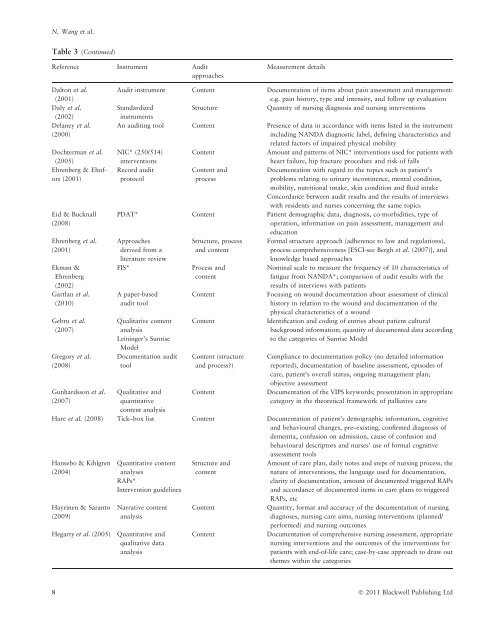Quality of nursing documentation and approaches to its evaluation ...
Quality of nursing documentation and approaches to its evaluation ...
Quality of nursing documentation and approaches to its evaluation ...
You also want an ePaper? Increase the reach of your titles
YUMPU automatically turns print PDFs into web optimized ePapers that Google loves.
N. Wang et al.<br />
Table 3 (Continued)<br />
Reference Instrument Audit<br />
<strong>approaches</strong><br />
Measurement details<br />
Dal<strong>to</strong>n et al.<br />
(2001)<br />
Daly et al.<br />
(2002)<br />
Delaney et al.<br />
(2000)<br />
Dochterman et al.<br />
(2005)<br />
Ehrenberg & Ehnfors<br />
(2001)<br />
Eid & Bucknall<br />
(2008)<br />
Ehrenberg et al.<br />
(2001)<br />
Ekman &<br />
Ehrenberg<br />
(2002)<br />
Gartlan et al.<br />
(2010)<br />
Gebru et al.<br />
(2007)<br />
Gregory et al.<br />
(2008)<br />
Gunhardsson et al.<br />
(2007)<br />
Audit instrument Content Documentation <strong>of</strong> items about pain assessment <strong>and</strong> management:<br />
e.g. pain his<strong>to</strong>ry, type <strong>and</strong> intensity, <strong>and</strong> follow up <strong>evaluation</strong><br />
St<strong>and</strong>ardized<br />
Structure<br />
Quantity <strong>of</strong> <strong>nursing</strong> diagnosis <strong>and</strong> <strong>nursing</strong> interventions<br />
instruments<br />
An auditing <strong>to</strong>ol Content Presence <strong>of</strong> data in accordance with items listed in the instrument<br />
including NANDA diagnostic label, defining characteristics <strong>and</strong><br />
related fac<strong>to</strong>rs <strong>of</strong> impaired physical mobility<br />
NIC* (250/514) Content<br />
Amount <strong>and</strong> patterns <strong>of</strong> NIC* interventions used for patients with<br />
interventions<br />
heart failure, hip fracture procedure <strong>and</strong> risk <strong>of</strong> falls<br />
Record audit<br />
Content <strong>and</strong><br />
Documentation with regard <strong>to</strong> the <strong>to</strong>pics such as patient’s<br />
pro<strong>to</strong>col<br />
process<br />
problems relating <strong>to</strong> urinary incontinence, mental condition,<br />
mobility, nutritional intake, skin condition <strong>and</strong> fluid intake<br />
Concordance between audit results <strong>and</strong> the results <strong>of</strong> interviews<br />
with residents <strong>and</strong> nurses concerning the same <strong>to</strong>pics<br />
PDAT* Content Patient demographic data, diagnosis, co-morbidities, type <strong>of</strong><br />
operation, information on pain assessment, management <strong>and</strong><br />
education<br />
Approaches<br />
derived from a<br />
literature review<br />
FIS*<br />
A paper-based<br />
audit <strong>to</strong>ol<br />
Qualitative content<br />
analysis<br />
Leininger’s Sunrise<br />
Model<br />
Documentation audit<br />
<strong>to</strong>ol<br />
Qualitative <strong>and</strong><br />
quantitative<br />
content analysis<br />
Structure, process<br />
<strong>and</strong> content<br />
Process <strong>and</strong><br />
content<br />
Content<br />
Content<br />
Content (structure<br />
<strong>and</strong> process?)<br />
Content<br />
Formal structure approach (adherence <strong>to</strong> law <strong>and</strong> regulations),<br />
process comprehensiveness [ESCI-see Bergh et al. (2007)], <strong>and</strong><br />
knowledge based <strong>approaches</strong><br />
Nominal scale <strong>to</strong> measure the frequency <strong>of</strong> 10 characteristics <strong>of</strong><br />
fatigue from NANDA*; comparison <strong>of</strong> audit results with the<br />
results <strong>of</strong> interviews with patients<br />
Focusing on wound <strong>documentation</strong> about assessment <strong>of</strong> clinical<br />
his<strong>to</strong>ry in relation <strong>to</strong> the wound <strong>and</strong> <strong>documentation</strong> <strong>of</strong> the<br />
physical characteristics <strong>of</strong> a wound<br />
Identification <strong>and</strong> coding <strong>of</strong> entries about patient cultural<br />
background information; quantity <strong>of</strong> documented data according<br />
<strong>to</strong> the categories <strong>of</strong> Sunrise Model<br />
Compliance <strong>to</strong> <strong>documentation</strong> policy (no detailed information<br />
reported), <strong>documentation</strong> <strong>of</strong> baseline assessment, episodes <strong>of</strong><br />
care, patient’s overall status, ongoing management plan;<br />
objective assessment<br />
Documentation <strong>of</strong> the VIPS keywords; presentation in appropriate<br />
category in the theoretical framework <strong>of</strong> palliative care<br />
Hare et al. (2008) Tick–box list Content Documentation <strong>of</strong> patient’s demographic information, cognitive<br />
<strong>and</strong> behavioural changes, pre–existing, confirmed diagnosis <strong>of</strong><br />
dementia, confusion on admission, cause <strong>of</strong> confusion <strong>and</strong><br />
behavioural descrip<strong>to</strong>rs <strong>and</strong> nurses’ use <strong>of</strong> formal cognitive<br />
assessment <strong>to</strong>ols<br />
Hansebo & Kihlgren<br />
(2004)<br />
Hayrinen & Saran<strong>to</strong><br />
(2009)<br />
Hegarty et al. (2005)<br />
Quantitative content<br />
analyses<br />
RAPs*<br />
Intervention guidelines<br />
Narrative content<br />
analysis<br />
Quantitative <strong>and</strong><br />
qualitative data<br />
analysis<br />
Structure <strong>and</strong><br />
content<br />
Content<br />
Content<br />
Amount <strong>of</strong> care plan, daily notes <strong>and</strong> steps <strong>of</strong> <strong>nursing</strong> process, the<br />
nature <strong>of</strong> interventions, the language used for <strong>documentation</strong>,<br />
clarity <strong>of</strong> <strong>documentation</strong>, amount <strong>of</strong> documented triggered RAPs<br />
<strong>and</strong> accordance <strong>of</strong> documented items in care plans <strong>to</strong> triggered<br />
RAPs, etc<br />
Quantity, format <strong>and</strong> accuracy <strong>of</strong> the <strong>documentation</strong> <strong>of</strong> <strong>nursing</strong><br />
diagnoses, <strong>nursing</strong> care aims, <strong>nursing</strong> interventions (planned/<br />
performed) <strong>and</strong> <strong>nursing</strong> outcomes<br />
Documentation <strong>of</strong> comprehensive <strong>nursing</strong> assessment, appropriate<br />
<strong>nursing</strong> interventions <strong>and</strong> the outcomes <strong>of</strong> the interventions for<br />
patients with end-<strong>of</strong>-life care; case-by-case approach <strong>to</strong> draw out<br />
themes within the categories<br />
8 Ó 2011 Blackwell Publishing Ltd

















